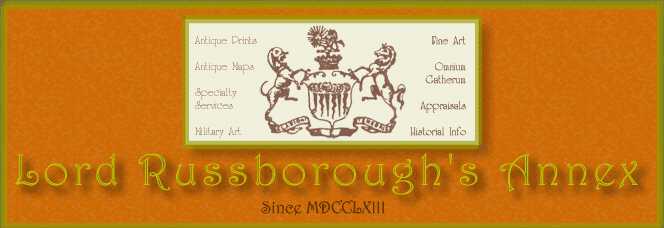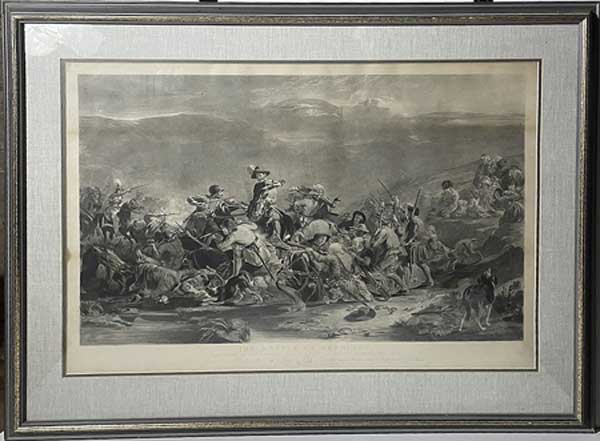The battle of Drumclog was the only occasion on which the Covenanters defeated the Royalist forces. Harvey had a genuine sympathy for the Covenanters.
The Presbyterians, having secured a position, in front of which was a morass/marshy bog or locally called ‘Stank’, the troopers were ordered to dislodge them, and in the attempt were thrown into disorder. The two leaders are conspicuous in the skirmish; Claverhouse is waiting the result of the charge; Thomas Hamilton, who commanded the insurgents is in the act of cutting down a trooper; Hackstown of Rathellet and the renowned Balfour of Burley, are engaged in combat in the background. The death struggle between an English officer, and the Laird of Torfoot, (whose life was saved by his dog. seizing the arm of his adversary) is painfully real. The venerable preacher, Rev.Thomas Douglas, armed only with ‘the book ‘is cheering on the combatants, and in the rear a peasant band eagerly respond to his cry, one man who’s few remaining hairs are grey takes aim with a musket. A sturdy covenanter, Muir of Ploughlands is cooly warding off the sword stroke of a dragoon. As women and children covenant followers look on, including a horrified mother whose young daughter has run into the fray after her father.
In 1670, a bill was passed making attendance at a conventicle (illegal meeting of political & religious supporters of a Presbyterian Church of Scotland) treasonable. Those who preached at the meetings were liable to be sentenced to death. One of the most prominent figures in the government army was John Graham of Claverhouse, better known to his enemies as 'Bluidy Clavers', had recently been appointed captain, with a mission to disperse conventicles in southwest Scotland. He became notorious in his military zeal in carrying out his duties in stamping out the Covenanting revolt. When news reached him that a large outlawed religious service or ‘conventicle’ was to be held at High Drumclog, in South Lanarkshire, Scotland, he set off with a body of troops to disperse them.
The government troops were well armed and well disciplined, but the Covenanters, whose numbers were greater, had the advantage of familiarity with the marshy terrain. They too were well armed, and they were well prepared for the attack. Claverhouse’s horsemen soon found themselves in difficulty on the soft and sodden ground. This effective selection of terrain by the rebels precluded a cavalry attack and so Claverhouse’s dragoons dismounted and advanced on foot to within pistol shot.
In response the rebels charged against the centre and left flank of the government deployment. At this point, the Covenanters decided to press the attack and the Covenanters laid into them ferociously, William Cleland led a force around the stank, and advanced rapidly. Despite heavy fire from the government troops, the attack was entirely successful. The line of Claverhouse's force broke, and the dragoons were soon routed from the battlefield, leaving 36 dead, and sending Claverhouse and the rest of the survivors into flight.
The victory spurred the Covenanters on to greater things. Several thousand stormed Glasgow, drove out the occupying garrison and by 6 June had taken command of the city. Their success was to be short-lived. Within two weeks the tide would turn against them.


